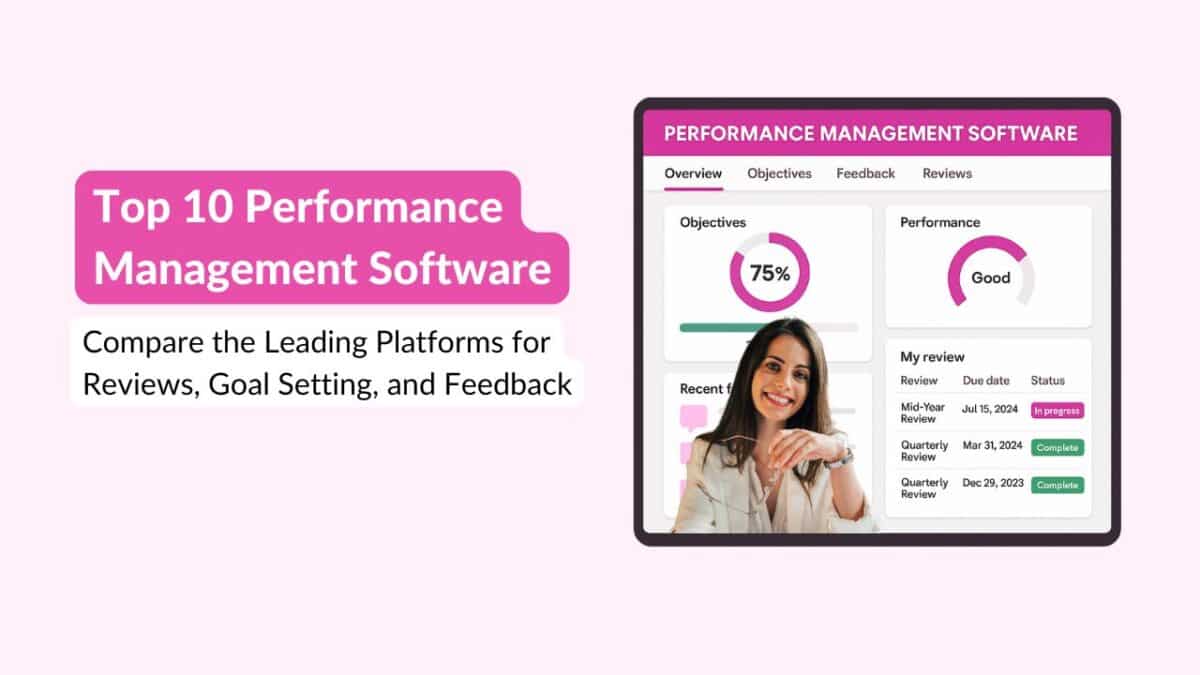“The Global Human Capital Trends report by Deloitte highlighted that 49% of executives found their Performance Management Process to be ineffective and required a complete overhaul.” The statistics highlight the importance of using the right performance management software to derive effective results.
In the last two years, organizations have remodeled their business processes to contain the impact of the pandemic and thereby boost the productivity of their employees working remotely and from the office.
However, regarding performance management, the achievement is not significant. A survey conducted by Kronos found that 95% of HR leaders feel that employee burnout is sabotaging their workforce retention. The problem calls for robust performance evaluation and performance review software that uses crucial parameters in managing and monitoring the workforce.
By utilizing performance review software, organizations can ensure that their review process is structured, efficient, and focused on measurable outcomes, ultimately leading to better employee performance and engagement.
This article will help you understand the intricacies of performance management systems and will explore the various features of top 10 performance management software. We will unpack the following in the below sections:
- What is a Performance Management Software?
- Importance of Performance Management Software
- Features of Performance Management Software
- Top Performance Management Software
TL;DR – Top 10 Performance Management Software (2025 Guide)
- Engagedly – AI-powered, all-in-one performance & talent management platform
- 15Five – Focuses on manager effectiveness and employee engagement
- Leapsome – Combines OKRs, feedback, and learning in one platform
- Reflektive – Strong in real-time feedback and engagement tracking
- PerformYard – Data-rich platform for customizable performance reviews
- Betterworks – Goal-focused tool with actionable insights and feedback
- Lattice – Unified platform for performance, engagement, and development
- 7Geese/Paycor – Integrated HCM with OKRs and coaching tools
- ClearCompany – Combines performance, hiring, and workforce planning
- Small Improvements – Lightweight solution for continuous feedback and reviews
What is Performance Management Software?
Performance management is a tool used by organizations globally to increase employee productivity and help them become successful in their job roles. The process encompasses continuous communication between a manager and employees for the mutual achievement of organizational goals.
Changing business needs and the latest technological developments have given rise to new-age performance management software that helps in holistic workforce management. The traditional practice of annual performance review is now transitioning into continuous process management.
The latest developments in performance management involve setting clear objectives and goals, task assignments, frequent check-ins, providing feedback at regular intervals, and analyzing the results. Through this, managers and leaders can track the performance of their employees and provide them feedback in real-time to help them perform better at their jobs.
Performance management helps organizations in utilizing the complete potential of their employees and provides effective measures to increase employee engagement, collaboration, and retention. Through the analytics feature offered by the tools, executives can look into the intricacies of performance management and create an actionable plan for performance improvement.
Importance of Performance Management Software
The primary aim of business performance management is to align leaders, managers, team members, and resources to meet the strategic goals of the business. By providing metrics to measure the performance and productivity of the system, leaders can gauge the early signs of a potential threat and create workarounds to get the business on track.
Continuous Performance Management (also known as Agile Performance Management) helps in creating a productive and skilled workforce by analyzing the performance gaps and offering solutions to increase productivity through training and mentoring.
Performance management tools are becoming increasingly important for organizations to be successful in the current business environment. By adopting performance management measures, leaders can understand the factors that are working well for the business and seek better results through proper implementation.
Employee performance management software can be highly beneficial to organizations. The following points highlight its importance in the workplace.
Also Read: How continuous performance management can help improve productivity?
Boost Employee Engagement and Productivity
(Globally, 85% of employees are disengaged or not actively engaged at work, resulting in massive loss of business and revenue- A report by Gallup). Employee engagement and productivity are directly linked to the success of an organization. Engaged employees are involved actively in their work and can create strong bonds with their colleagues.
By utilizing continuous performance management, organizations can create an environment of trust, support, and encouragement. Strategic implementation of a performance management solution helps in aligning the individual goals with the organizational goals.
Employee Reskilling and Upskilling
A LinkedIn 2021 workplace learning report shows that 94% of employees would have stayed longer at their last organization had the company invested in their learning and development. The report also highlighted that the interest and zeal to learn is highest among the younger workers belonging to Gen Z.
Providing mentoring and coaching to employees not only helps them perform better at their jobs but also motivates them to take up more responsibilities. By reskilling and upskilling employees, organizations can attract new talent and train existing employees to take up managerial positions.
Employee development is at the heart of business performance management solutions, and organizations can reap numerous benefits by using them effectively.
Improves Workplace Communication and Collaboration
A report by McKinsey highlights the importance of communication in the workplace. It states that improved communication can increase the productivity of interacting employees by 20-25%. Another report by CMSWIRE states that 85% of employees use more than one device for communication.
The statistics outline the importance of clear and efficient workplace communication. The major difference between a performing and a non-performing team is efficient communication. By improving communication in the workplace, organizations can improve employee efficiency and mitigate critical risks that lead to the failure of the organization.
Top 10 Performance Management Systems in 2025
The successful implementation of software can cause a ripple effect in the organization. It helps in aligning the workforce towards the business goals and makes employee engagement and collaboration easier.
As many organizations are paving their way to digitizing and modernizing their performance systems, the following list of employee performance management software will be helpful to them in selecting the right tool that matches their organizational needs and objectives.
- Engagedly
- 15Five
- Leapsome
- Reflektive
- Performyard
- Better Works
- Lattice
- 7Geese/Paycor
- ClearCompany
- Small Improvements
1. Engagedly
Engagedly is an AI-powered talent management platform designed to help organizations build high-performing, people-first cultures. At the heart of Engagedly is Marissa AI, an Agentic AI layer that automates repetitive HR tasks, delivers real-time insights, and empowers HR leaders, managers, and employees to focus on strategic, impactful work.

Built around the E3 framework—Engage, Enable, Execute, Engagedly seamlessly blends performance management, employee engagement, development, and recognition into one unified platform. From OKRs and 360-degree feedback to skill development and cultural alignment, every feature is designed to drive measurable outcomes.
What Sets Engagedly Apart:
- Agentic AI Capabilities: Role-based AI agents handle tasks like onboarding, feedback nudges, learning recommendations, meeting summaries, and engagement analysis—freeing up teams for high-value work.
- Scalable & User-Friendly: Intuitive for both employees and HR teams, and adaptable across organizations of all sizes.
- Proven Impact: Companies using Engagedly have seen 2.5× faster goal alignment, 60% reduction in review cycle time, and over 30% improvement in employee development plan completions.
Key Solutions Offered:
- OKR & performance management consulting
- Performance reviews & 360 feedback
- OKR alignment, goal setting & tracking
- Continuous 1:1 check-ins & project reviews
- Leadership development & succession planning
- Employee engagement surveys & analytics
- Personalized learning & skill-building paths
- Onboarding workflows
- DEI & cultural alignment initiatives
- AI-driven talent insights & recommendations
2. 15Five

15Five is a tech-powered platform that offers employee engagement, continuous performance management, and manager effectiveness. The solution combines software, education, and community to build effective managers and improve employee performance.
Solutions offered by 15Five:
- Increasing Engagement
- Improving Manager Effectiveness
- Remote Team Development
- Aligning Company Success
- People Development
3. Leapsome

This software provides a continuous cycle of performance management and personalized learning through features like OKR management, performance reviews, employee engagement surveys, feedback, and praise. It helps in aligning the workforce towards organizational goals.
Solutions offered by leapsome:
- Goals and OKR management
- 1:1 and team meetings
- Personalized learning and development
- Engagement surveys with real-time insights
- Development framework for employee growth
4. Reflektive

Reflektive is a comprehensive performance evaluation software that assists in business growth through continuous improvement. The tool helps increase productivity through constructive employee engagement and driving growth through high-performance-driven teams.
Solutions offered by Reflektive:
- Real-time Feedback
- Easy and quick employee recognition
- Multiple user tagging
- Performance and talent calibration
- Increase and measure employee engagement through surveys
5. PerformYard

PerformYard is a scalable performance management platform that provides intelligent insights about the workforce through data-driven features. It helps in executing performance reviews, frequent check-ins, real-time feedback, and inputs from throughout the organization.
Solutions offered by performyard:
- Managing qualitative, quantitative, individual, and team OKRs
- Supports upward, downward, lateral, and external reviews
- Continuous feedback management
- HRIS and new employee onboarding workflows
Also Read: How to build performance management metric strategy?
6. Betterworks

Betterworks helps enterprises scale up their performance by providing intuitive and directional insights. This performance management tool helps create a vision with the right set of goals, reviews, and continuous feedback from the employees. Managers can use features like reviews and check-ins, goal management, and continuous feedback for performance enhancement.
Solutions offered by Betterworks:
- Deploy and track progress
- Individual progress tracking
- Dashboards for clear visualization
- Gathering intelligent performance insights
- 1:1 feedback mechanism
7. Lattice

Lattice provides engaging features for enterprises and supports employee growth and development. The software uses intelligent methodologies to combine performance management, employee engagement, and employee development into one holistic solution.
Solutions offered by lattice:
- OKR and goal management
- Continuous performance tracking through 1:1 reviews, feedback, and praise
- Actionable people insights
- Continuous employee development through growth plans
8. 7Geese/Paycor
It is a human capital management tool that offers a range of services, like HR & payroll management, talent management, workforce management, and employee experience. It helps in building an engaging and collaborative culture to enhance organizational performance.
Solutions offered by 7Geese/Paycor
- 1:1 and feedback tools
- Automated workflows to eliminate repetitive tasks
- Customizable dashboard for coaching sessions
- OKRs and goal management
ClearCompany
ClearCompany offers a platform that combines recruitment, onboarding, performance management, and workforce planning into one ambit. It offers a range of solutions that help organizations develop and nurture talent for higher performance.
Solutions offered by ClearCompany:
- Workforce planning and analytics
- Employee onboarding
- Employee engagement tools and surveys
- Performance management system
9. Small Improvements

Small Improvements is a lightweight performance management platform built for growing teams. Used by companies like Duolingo, SoundCloud, and Zapier, it helps foster a culture of continuous feedback, alignment, and development.
Key Features:
- Customizable performance reviews & 360° feedback
- Lightweight goals & objectives
- Real-time feedback & praise
- 1:1 meeting agendas & notes
- Pulse surveys & engagement insights
- Integrations with tools like BambooHR, Slack, and Google
Ideal for companies with 10–1350 employees, Small Improvements offers a flexible, user-friendly toolkit to improve performance and employee experience.
Features of Top Performance Management Software
While selecting the best performance management software for the organization, it is imperative to look for some desirable features in the tool. The crux of implementing a system is to ensure performance improvisation throughout the organization and automate several manual tasks to avoid critical human errors.
Looking for the right performance management tool can be a lengthy process if the desired objectives and goals of the performance management system are not clearly defined. Conducting surveys and interviews within the firm can shed some light on the objectives.
Once the objectives are enumerated, HR managers should relate them to the below features and zero in on the tool that will meet organizational requirements. Check out the below features while selecting the best performance management platform.
Continuous Feedback Mechanism
The mechanism calls for a continuous, open, and cyclical feedback exchange between the manager and employees. It helps in finding the performance gaps of an employee and starting an improvisation plan. Through this process, managers can ensure project deliveries are not hampered and employees are getting continuous feedback on their work.
360 Degree Feedback
Also known as multi-rater feedback, it involves taking anonymous employee feedback from the colleagues he/she has a working relationship with. Managers, peers, direct reports, and subordinates all submit their feedback through a specialized mechanism.
360-degree feedback, when integrated into performance review software, provides insight into the behavior, attitude, and work relationships of employees. The unbiased nature and subjectivity of 360-degree feedback make it more acceptable to employees.
Also Read: How to effectively review employee performance?
Automated and Intuitive
A performance management solution should be user-friendly and easy to understand. The system should help in automating tasks that require regular check-ins and error-free delivery. By sending automated reminders, it can help reduce the turnaround time and delays in submissions. Business performance management software offers customizable surveys and dashboards that aid in the easy collection and visualization of employee feedback.
People Analytics
Also referred to as talent analytics or HR analytics, it is a data-driven method to study people, processes, challenges, and opportunities in the workplace. The talent insights collected through the rigorous process aid in making smarter decisions, succession planning, and improving the capabilities of the workforce.
Many organizations are heavily focused on people analytics to make HR business strategy decisions like recruitment and selection, learning and development, project management, and KPI creation and setting.
Social Performance Management
Social connection and engagement go a long way in today’s virtual business environment. In the last 2 years of the pandemic, employees working remotely have faced a lot of disconnect from their teams and organization, leading to proximity bias and reduced productivity.
Social performance management, or SPM, is a part of the software that provides a solution to stay connected within the organization by letting employees share ideas, opinions, and thoughts with everyone in the organization. Employees can ask for real-time feedback from their colleagues or managers.
Employee Reward and Recognition
(As per a survey conducted by Achievers, more than half of 1,700 respondents are actively looking out for new jobs, citing lack of recognition in the workplace). Employee reward and recognition is one key parameter that organizations need to look for in retaining potential employees.
A well-implemented reward system helps in boosting employee productivity and makes them feel valued in the workplace. Through gamification, performance management software encourages employees to reward each other for their contributions and outstanding performance.
Setting SMART Goals
A report published by Gallup highlights that over 50% of employees are not clear about what is expected from them at the workplace. Introduced in 1981 by George T Doran, SMART refers to Specific, Measurable, Achievable, Relevant, and Time-bound goals that help organizations in measuring employee performance through a defined metric.
Goal setting is one of the most critical and time-consuming processes in an organization. Yet, it has many advantages, such as providing clear expectations to the employees, reduced turnaround time, and higher productivity & engagement.
It helps in quantifying the performance of employees and offers insights to managers for plugging in performance gaps. A performance management solution aids in setting SMART goals that help in measuring employee performance in real-time.
Learning Management System
Learning is at the core of a performance management tool. It helps in assessing the current skills of an employee and charts out a defined path to develop and grow in the organization. Employees can use the module for self-assessment and set goals for themselves to hone their skills. Managers can assign certain learning modules to their employees to help them learn new skills.
Most of the employees are concerned about their skill development and career progression, so having a learning module in the system makes them feel cared for.
Customization, Security, and Integration
An important aspect of performance review software is its integration with other HR technologies and tools. As organizations these days use multiple tools for employee management, it is a fundamental requirement for software to seamlessly integrate with these tools for a better employee experience.
The various modules available in the system can also be customized as per the business needs and provide data security as per the business standards.
Concluding Words
Performance management software is the key to building a skilled, motivated, engaged, and performance-driven workforce. In the highly competitive and rapidly changing business environment, the success of an organization lies in how well it is managing its employees.
By shifting from traditional tools to modern tech-loaded systems, organizations can bring a real impact on their business. We hope the information shared in this article will help you in selecting the best performance evaluation software.

































